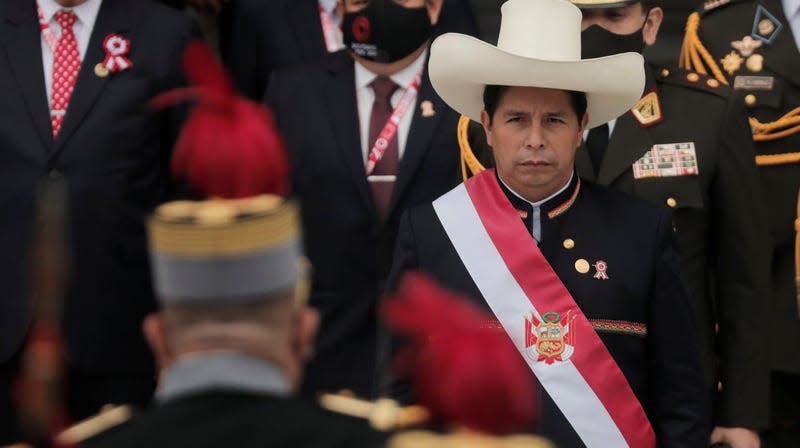Peru's president was removed from office after he attempted to dissolve the congress and subvert democracy

- Oops!Something went wrong.Please try again later.
- Oops!Something went wrong.Please try again later.
After two failed impeachment attempts, Peruvian president Pedro Castillo got removed from office.
The president of Peru was removed from office and taken into national police custody on Dec. 7 after a coup attempt in which he planned to dissolve congress and form an emergency government.
Peruvian vice president Dina Boluarte was quickly sworn in as president at a ceremony in the nation’s capital.
Read more
President Pedro Castillo announced plans to seize power ahead of a scheduled impeachment vote this morning following accusations of widespread corruption, the third attempt to remove him from power since he was elected in 2021.
It quickly became clear that Castillo did not have the support he needed to stay in power. Almost immediately, several senior members of Castillo’s cabinet resigned in protest of Castillo’s actions, including foreign minister Cesar Landa, while the army and national police released a joint statement condemning the attempted coup. Landa, the former president of the Constitutional Court, said Castillo’s actions violated the constitution.
Peru’s fragile democracy
The constitutional crisis comes at a fragile time for Peru’s democracy, which has seen four presidents in the last four years. In 2019, president Martín Vizcarra successfully dissolved Peru’s congress before being removed by the new legislature the next year.
Ultimately, the Castillo impeachment vote went on without incident, with the national congress voting 101-6 to remove Castillo from power, with 10 abstentions. The president of the congress, Jose Williams, signed a resolution accusing Castillo of showing a “permanent moral incapacity” to lead the country.
Boluarte is Peru’s first woman president
Newly sworn-in president Boluarte condemned Castillo’s attempt to remain in power and pledged in her first speech to the legislature to form a national unity government. She is the first woman to serve as president in the history of the Peruvian republic.
While Castillo was historically unpopular with the Peruvian people, the congress that impeached him is even less popular. According to a poll conducted by IEPeru in November, Castillo had a disapproval rating of 61%, while the disapproval rating for the congress was 86%
Lisa Kenna, the US ambassador to Peru, tweeted in Spanish that the US rejects any “extra-constitutional” actions by Castillo to remain in power, and neighboring Chilean president Gabriel Boric called on Peru’s democratic institutions to prevail.
The attempt to seize power had shades of the 1992 so-called autogolpe, when then-president Alberto Fujimori successfully dissolved the national congress and judiciary. Ruling for eight years, Fujimori presided over a repressive military dictatorship and is currently imprisoned after being convicted of human rights violations and corruption.
Castillo, who ran for office as a member of the Peruvian Marxist party, is considered part of the second Pink Tide in South America, or the recent electoral success of several left-wing politicians. His impeachment, as well as the recent conviction of Argentina’s center-left vice president Cristina Fernández de Kirchner on corruption charges, is likely to reverberate across the continent and could weaken a wave of rural, anti-establishment political movements that have surged in Latin America in recent years.
More from Quartz
Sign up for Quartz's Newsletter. For the latest news, Facebook, Twitter and Instagram.

